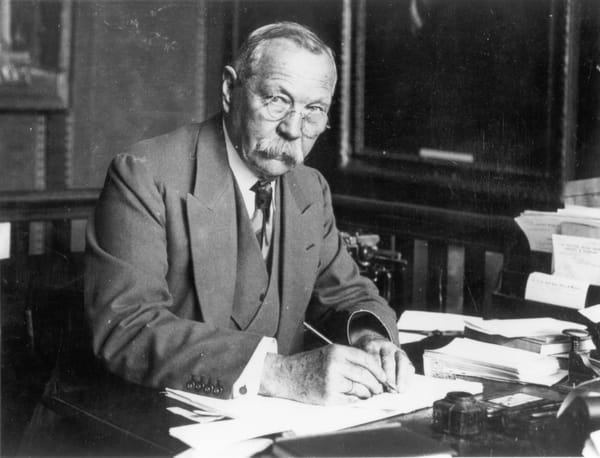Note 1: Slowing down?
You really have no choice how fast you are going.
Welcome to the inaugural edition of "Notes from the Void", a newsletter or blog (Which one is up to you!) that I'm trying as an experiment in writing and to share thoughts and content that I encounter throughout the week. I recently left Facebook and was a bit surprised at how many people wrote to me to express that they liked the random stuff that I was sharing, so I'm hoping to use this space in a much more intentional way to do exactly that.
A quick introduction, before I proceed: my name is Chris Karr and I'm an entrepreneur in the Chicago area and the bulk of my entrepreneurial activity happens under the umbrella of my company, Audacious Software, which (currently) primarily provides software development and other consulting services to small businesses and research institutions. The nature of the work that I take on is highly speculative – typically creating stuff that doesn't exist, and then managing the challenges of integrating it into The Real World once it does exist. In addition to selling my services to others, I also have a small menagerie of other stuff that I build and maintain, mainly because I'd be annoyed if that stuff didn't exist, and who better to instantiate it than me?
Since a large portion of my Facebook activity was political, it's worth putting out there that my political compass points largely in the same direction as the folks over at The Dispatch (whose newsletter approach I'm shamelessly stealing here). I think of myself as a classical liberal with a "small-c" conservative lean towards local control and markets as the best mechanisms for managing societies. While I expect that some political content may show up in this space eventually, I'm currently taking a break from that, given that I don't have anything useful to contribute to the conversation at the moment, and I'm pretty burned out on it right now.
One final caveat: In the last few months, I've gotten totally sucked into the "Elite: Dangerous" gaming universe, and you may see some Elitist metaphors and phrases used in discussion. The name of this newsletter is inspired by my current (in-game) journey from the supermassive black hole at the center of the Milky Way back to the Bubble of human habitation (as imagined in the 32nd century). In the game, less than one percent of the galaxy has seen humans visit, so "the Void" refers to the tens of thousands of light-years one can spend without encountering a trace of humanity, jumping from point A to point B. On this newsletter/blog, I think about the Void being what bounces around in my head when I'm left to my own thoughts, and that's what you'll be getting here.
Welcome to the Void, and let's prepare our Frame Shift Drives to jump to the first real topic...
We are all traveling at the speed of light.
One of the first things that I noticed when I started playing "Elite: Dangerous" was to what extent the in-game experience demolished and rebuilt my sense of scale. To recap, the game is set in a 1-to-1 scale model of the Milky Way galaxy with over 400 BILLION stars that a player could theoretically visit.
The game takes distance seriously, and there are three modes that players can use to travel through the cosmos. Regular flight takes place at sub-light speeds and is what we're currently constrained to in our current and anticipated technology for the foreseeable future. Speeds in regular flight range from zero to several hundred meters per second. Supercruise is a mode where you can go from 30 kilometers per second up to 2,000 times the speed of light. Finally, a Frame Shift Jump is where you ship can enter another dimension colloquially called "Witch-space" where your ship can travel from star system to star system on a scale of one or two light years all the way up to 80 light years in less than a minute. (My current ship, the Asp Explorer BOOMKIN III, has a jump range of 44 light years.)
These three modes make the game playable within the span of human lifespans, and I'll talk more about that in future installments. However, for the sake of this note, I want to focus on Supercruise, since it is the part of the game that exhibits the most experiential variance. Players spend most of their times navigating individual star systems at some speed that's a multiple of the speed of light, and in the game, it doesn't feel so much like you're moving faster, as it space around you that's getting smaller. If you don't pay attention to that, you can easily zoom past a large gas giant or star if you're not paying attention to the relationship between your speed and your estimated time of arrival and keeping the latter a constant (7 seconds) while varying the former. While the experience itself remains stubbornly Newtonian – you do not experience relativistic time dilation – it does serve as a useful jumping off point for a recent article by Lenka Otap that I read about how fast we're all moving.
Spoiler alert – every one of us is moving at light speed:
Spacetime is a 4-dimensional concept, the three spatial dimensions, also called space, and one temporal dimension. Our speed is spread between the four components, and since the speed has a direction, we call it velocity. The 4-velocity is the vector U = γ(𝑐,𝑣_𝑥,𝑣_𝑦,𝑣_𝑧) where γ is the Lorentz factor.
It doesn't matter for the equations, how we spread our movements through the 3 space-dimensions x, y, and z, we only care about the speed, not the velocity with a specific direction, so we say that the movement is broken in two components, space and time.
When we are still, e.g. don't move through space (as seen in our own frame of reference), then we move through time at the maximum speed. When a photon moves at the maximum speed, c, then it doesn't move through time at all. For a photon there is no time component.
I found this to be an extremely fascinating way to think about the relationship between space and time, it's a useful intuition pump for some of the less intuitive aspects of relativistic physics.
Now before I proceed further, let me add my Physics Disclaimer here: My formal physics education ended around my sophomore year of college, when I switched my undergraduate major from Electrical Engineering to Computer Science. It's a topic that I continue to have quite a bit of interest in, but primarily as a "gee wiz, isn't that cool" amateur than anyone who has seriously practiced it as a discipline. Things I'm about to say may be completely basic or even incorrect, and I encourage folks who know better to let me know in the comments below.
Now, aside from The Tragedy of the Perceptive Photon (it experiences both its creation and annihilation at the same time), when you plot your speed through space and time as a two-dimensional graph (space on the X axis, time on the Y axis), you end up with a half circle.

You can move left and right by going forward and backward in space, but your time plot can only go from 0 to +c, not -c to +c. If movement through space was like movement through time, that plot would look like a quarter circle, and if movement through time was like movement through space, that plot would look like a full circle. That discontinuity is really interesting to me.
Thinking about it, the only physical analog that I could recall that has a similar property is the event horizon of a black hole. To recap, the event horizon is the boundary around a black hole where the gravitational attraction is so strong that not even photons can escape. Once you pass the event horizon, you're on a one-way trip down the gravity well and you can't even send a signal to let anyone know. That's what makes black holes "black".
Regarding the question of why our velocity plots of space versus time are half-circles instead of full circles in regular space outside the event horizons of black holes (where the half-circle turns into a quarter circle, since everything is traveling one direction), it made me wonder (warning: see Physics Disclaimer above) if we're already trapped in something like a temporal black hole and that's what prevents time from behaving the same way as space with "forwards" and "backwards". The end of time then is we (or more accurately, our constituent matter and energy) finally make it to that singularity at the center of the temporal black hole.
There's a certain poetic quality about that and my mind has been chewing on it all week.
Local updates
The weather in Chicago is starting to cool down, and after a record hot summer, I'm working on using the cooler temperatures to revitalize the plant life around Fremont Place. The struggle's been that the heat has made it difficult to keep everything watered sufficiently, and I'm hoping that the cooler temperatures will both bring more natural rains back, and help my weekly watering sessions stretch out more throughout the week as I use the months of September and October as one last sprint to get life established before the winter.
Occupational updates
As I write this, I'm waiting for my continuous integration system to sign off on upgrades that I made to some software infrastructure upgrading it from Python 2.7 to Python 3. I've been busy enough with ongoing client work that updating the code bases to support Python 3 has been pushed to the back burner, leading to some amount of stress. (Python 2 support ended in January.)
One of the biggest questions that I face daily isn't whether I'm getting stuff done, but whether I'm getting the *right stuff* done. This is the classical technical debt scenario, but I decided to bite the bullet and use one of my clients' projects as the one where this work gets done. I've structured my process so that if it works for them, it waterfalls and I can deploy it easily for others, so there's a nice path forward. And to be honest, so far the migration path has been easier than expected – there's lots of existing infrastructure to support the migration. I ended up spending most of my time reordering import statements and adding Pylint annotations to get everything to fall into line. There's still plenty of testing that I need to do, but that was due to happen anyway with the new client site. Anticipating no major surprises, it will be extremely relieving to have this in the rear view mirror.
Interesting reads from the week
Evangelicals are looking for answers online. They’re finding QAnon instead. (MIT Technology Review)
The Three-Body Problem Gains Game of Thrones’ Showrunners for Its Netflix Adaptation (io9)
It Has Come to This: Ignore the C.D.C. (New York Times)
The Wildest Insurance Fraud Scheme Texas Has Ever Seen (Texas Monthly)
The election security hole everyone ignores (Politico)
Airline Pilots Landing At LAX Report "A Guy In Jetpack" Flying Alongside Them (The Drive)
Until next week, happy flying, CMDRs. o7!



